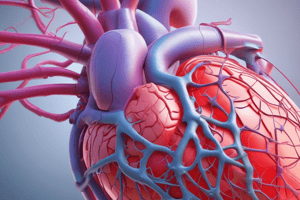Podcast
Questions and Answers
As blood flow continues into the ventricles from the atria, the ventricular pressure will ____.
As blood flow continues into the ventricles from the atria, the ventricular pressure will ____.
increase
With all the valves closed and the ventricles in systole, the volume inside the right ventricle ____.
With all the valves closed and the ventricles in systole, the volume inside the right ventricle ____.
remains constant
With the pulmonary valve now open, the volume of blood currently inside the right ventricle chamber ____.
With the pulmonary valve now open, the volume of blood currently inside the right ventricle chamber ____.
decreases
With the pulmonary valve now closed, the volume of blood currently inside the right ventricle chamber ____.
With the pulmonary valve now closed, the volume of blood currently inside the right ventricle chamber ____.
What valves are positioned during the ventricular filling phase?
What valves are positioned during the ventricular filling phase?
During ventricular filling, pressure in the left ventricle should be _____ aortic pressure.
During ventricular filling, pressure in the left ventricle should be _____ aortic pressure.
Which heart chamber(s) contract to complete ventricular filling?
Which heart chamber(s) contract to complete ventricular filling?
Which portion on the ECG graph precedes atrial systole?
Which portion on the ECG graph precedes atrial systole?
Which portion on the ECG graph immediately precedes isovolumetric contraction?
Which portion on the ECG graph immediately precedes isovolumetric contraction?
Which chamber(s) of the heart should be in systole during isovolumetric contraction?
Which chamber(s) of the heart should be in systole during isovolumetric contraction?
What is the valve position during the isovolumetric contraction phase?
What is the valve position during the isovolumetric contraction phase?
What is the valve position during the ventricular ejection phase?
What is the valve position during the ventricular ejection phase?
During ventricular ejection, ventricular volume should ____.
During ventricular ejection, ventricular volume should ____.
Which chamber(s) of the heart are in systole during ventricular ejection?
Which chamber(s) of the heart are in systole during ventricular ejection?
Which portion on the ECG graph precedes isovolumetric relaxation?
Which portion on the ECG graph precedes isovolumetric relaxation?
Which chamber(s) of the heart should be in diastole during isovolumetric relaxation?
Which chamber(s) of the heart should be in diastole during isovolumetric relaxation?
What is the valve position during the isovolumetric relaxation phase?
What is the valve position during the isovolumetric relaxation phase?
Which heart valves create the second sound of the heartbeat when they close at the beginning of isovolumetric relaxation?
Which heart valves create the second sound of the heartbeat when they close at the beginning of isovolumetric relaxation?
During isovolumetric relaxation, ventricular pressure ____.
During isovolumetric relaxation, ventricular pressure ____.
Flashcards are hidden until you start studying
Study Notes
Cardiac Cycle Overview
- A continuous cycle of events in the heart responsible for blood flow throughout the body.
- Involves contraction (systole) and relaxation (diastole) phases.
Ventricular Filling Phase
- Blood flows from the atria into the ventricles, causing an increase in ventricular pressure.
- Atrioventricular valves (tricuspid and mitral) open, while semilunar valves (pulmonary and aortic) remain closed until ventricular pressure exceeds aorta and pulmonary trunk pressure.
- Pressure in the left ventricle is less than aortic pressure, keeping the aortic valve closed.
- Atrial contraction completes ventricular filling.
Electrical Activity in the Heart
- The P wave on an ECG indicates atrial depolarization, triggering atrial systole.
- The QRS wave represents ventricular depolarization, marking the beginning of isovolumetric contraction.
- The T wave indicates ventricular repolarization, signaling the start of isovolumetric relaxation.
Isovolumetric Contraction Phase
- All heart valves (both atrioventricular and semilunar) are closed, resulting in constant ventricular volume.
- Ventricles are in systole, preparing to eject blood into the pulmonary trunk and aorta.
Ventricular Ejection Phase
- The pulmonary and aortic valves open as ventricular pressure rises, allowing blood to be ejected.
- During this phase, ventricular volume decreases as blood is pumped into systemic and pulmonary circuits.
Isovolumetric Relaxation Phase
- Following ventricular ejection, all valves are closed, preventing blood movement into or out of the ventricles.
- Ventricles relax, leading to a decrease in ventricular pressure.
- The closure of the pulmonary and aortic valves produces the second heart sound.
Summary of Heart Valve Positions
- During Ventricular Filling: Tricuspid and mitral valves open; aortic and pulmonary valves closed.
- During Isovolumetric Contraction: All valves are closed.
- During Ventricular Ejection: Pulmonary and aortic valves open; tricuspid and mitral valves closed.
- During Isovolumetric Relaxation: All valves are closed.
Key Points
- Ventricular pressure dynamics change throughout the cardiac cycle, influencing valve positions and blood flow.
- Atrial contraction is crucial for completing the filling of ventricles.
- Electrical signals coordinate the heart's rhythmic contractions, indicated by specific waves on the ECG.
Studying That Suits You
Use AI to generate personalized quizzes and flashcards to suit your learning preferences.




